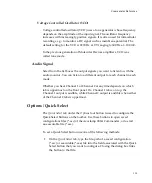
User
Guide
for
Axoclamp
900A
Balance
(see
Bridge
Balance
in
this
chapter).
If
you
go
too
far
the
overshoot
may
become
a
damped
oscillation,
which
may
escalate
into
a
continuous
oscillation,
killing
the
cell.
Sometimes
the
overshoot
is
difficult
to
see.
In
this
case,
you
may
prefer
to
look
at
the
“Scaled
Output:
Membrane
Potential”
trace
at
high
gain
on
an
oscilloscope,
advancing
the
Pipette
Capacitance
Neutralization
value
until
the
trace
becomes
noisy
and
oscillations
seem
imminent.
It
is
usually
prudent
to
reduce
the
Pipette
Capacitance
Neutralization
setting
slightly
from
the
optimal,
in
case
the
capacitance
changes
during
the
experiment.
Limitations
of
Capacitance
Neutralization
Use
of
capacitance
neutralization
is
less
desirable
than
physically
minimizing
C
in2
,
since
the
neutralizing
circuit
adds
noise
to
the
voltage
signal.
It
is
important
to
recognize
that
the
capacitance
neutralization
circuit
is
not
more
than
90%
effective
even
for
ideal
microelectrodes.
This
is
because
of
the
finite
frequency
responses
of
the
headstage
amplifiers
and
the
capacitance
neutralization
circuit,
and
also
because
C
in2
does
not
behave
ideally
as
a
linear
lumped
capacitor.
Consequently,
the
amount
of
C
in2
that
the
circuit
must
neutralize
should
be
kept
as
small
as
possible
(see
Chapter
4,
Sharp
Microelectrode
Recording
).
Oscillation
Detection
and
Removal
The
Axoclamp
900A
supports
automatic
oscillation
detection
and
removal
when
using
Pipette
Capacitance
Neutralization;
see
Detect
Oscillation
.
Pipette
Offset
The
Pipette
Offset
control
is
located
in
the
upper
right
corner
of
both
V
‐
Clamp
and
I
‐
Clamp
tabs.
It
consists
of
a
Zero
button
with
a
padlock
button
to
“lock”
it,
and
a
glider
control
for
manual
adjustment
following
use
of
the
Zero
button.
144
















































